

Before braces are placed, patients must visit a dentist for an exam and have any necessary fillings. Patients should visit the dentist every 6 months for a thorough examination and cleaning. Before each orthodontic appointment, patients are encouraged to brush their teeth.
Your appointments are scheduled to fit your busy lifestyle. Our staff makes every effort to accommodate each patient’s schedule. In order to help us continue to schedule efficiently, a 24 hour notice is required to cancel an orthodontic appointment.
Orthodontic treatment may last from 18 to 36 months, though this will vary depending on your individual case. Appointments are typically scheduled 4 to 12 weeks apart. Your cooperation in keeping scheduled orthodontic appointments, maintaining proper hygiene and taking care of your braces may allow you to finish your orthodontic treatment early.
We encourage patients to ask questions about their orthodontic treatment. At a patient’s first visit, Dr. Stoutland and Dr. Hayes will inform patients and/or parents about important treatment details.
Now that you have started orthodontic treatment, here are a few hints to help get you through the first several days with minimum of discomfort.
Be careful to protect the orthodontic appliances when you eat. Faithfully follow our instructions on foods to avoid. For the first day or so, soft foods will be more appropriate. Avoid tough meats, hard breads, and raw vegetables plus the foods on the food list.
This is to be expected throughout treatment. It is normal so don’t be upset. The teeth will again become rigidly fixed in their new positions. Teeth must loosen first so they can be moved.
There might be a general soreness in the mouth. This can be relieved by rinsing the mouth with a warm salt-water mouthwash. Dissolve one teaspoonful of salt in 8 ounces of warm water, and rinse your mouth vigorously. If the tenderness is severe, take Tylenol, Advil or whatever you normally take for headache or similar pain. Soreness should end by the third or fourth day.
As a general rule, an emergency appointment may be made when there is severe discomfort, a loose band, a broken wire or something sticking out that you can’t take care of. Please call us if the office is closed and you are in discomfort. Instructions are on the answering machine.
If you take part in athletics, it’s important that you consult us for special precautions. Everyone who plays contact sports should wear a mouthguard. In case of any accident involving the face, check your mouth and the appliance immediately. If teeth are loosened or the appliances damaged, phone at once for an appointment. In the meantime, treat your discomfort as you would treat any general soreness.
Success of treatment depends upon cooperation between you and the doctor and staff. Wear the appliances as directed, avoid the foods that can be damaging and handle emergencies promptly. Always be conscientious and responsible toward your treatment. Quick, successful results depend on you, too. It’s very important that you keep your teeth, gums and appliances clean. At least once each day, spend a few moments with a mirror checking the appliances to make sure they are thoroughly clean and in good shape.
If a wire or band comes loose, don’t be alarmed. This happens occasionally. If a wire protrudes and is irritating, use a blunt instrument (back of spoon or the eraser end of a pencil) and carefully, gently push the irritating wire back in place. Simply, get it out of the way. If irritation to the lips or mouth continues, place wax or wet cotton on the wire to reduce the annoyance. Telephone our office as soon as possible for an appointment to check and repair the appliances. If any piece comes off, save it and bring it with you to the office.
Brush two, preferably three, times a day for a minimum of four minutes each time. Pay special attention to the “danger zone” between the gum and the braces. This is the most difficult area to keep clean. Every night after you brush, before you go to sleep, rinse with fluoridated mouth wash (either ACT or Fluoroguard). We may also give you a prescription for Prevident. Only use either the mouthwash or Prevident, do not use them together. Rinsing or brushing with fluoride reduces the possibility of getting a cavity by 80%.
Always smile and be proud of your appliances. After all, it shows the world that you take very good care of yourself.
Band – ring of metal that was placed around the tooth
Remember to bring all removable biteplates, headgears, retainers, etc. to EVERY appointment.
If your band comes loose or brackets come unglued, call the office BEFORE your appointment so we can be prepared to repair the broken part. If we are not informed, we may not be able to fix it until your following appointment.
Your braces will be attached quickly and easily to your teeth, but a full day is necessary for the bands to completely affix. It is a good idea to wait several hours after getting braces before eating solid food. You may find it easier to eat soft foods for the first couple of days while you are becoming accustomed to eating with your new braces.
The braces may feel a little awkward at first and the teeth may be tender or sensitive to pressure. This is completely normal and will go away soon. It may feel as though the braces are “sticking out,” but this sensation will also soon pass. Small pieces of orthodontic wax may be used if the brackets irritate cheek tissues. Our office always has extra wax in case you run out so call us if you need more.
Many patients will experience some discomfort at first, but the soreness will go away within the first few days or even hours of getting braces. It is impossible to predict exactly when the tenderness will end. Some patients choose to take over-the-counter pain relievers the first day of treatment to lessen the discomfort. To ensure the best result take the medications before your appointment.
Braces are attached to your teeth with a strong adhesive, but may become loose as a result of eating certain foods. It is also possible that wires could become bent or broken without proper care. Since it is best to achieve orthodontic treatment goals with as few disruptions as possible, a well-balanced diet is important to ensure a healthy environment for your teeth.
Patients should avoid foods that are sticky, hard or chewy. They should also avoid any food and drinks that are known to cause cavities. Patients should brush, floss and rinse their mouth regularly between meals.
It is usually difficult to know if treatment is necessary because there are many problems that can occur even though the front teeth look straight. Asking your general dentist is always a good starting point. Since our initial exam is complimentary, call us today to schedule a consultation and ask orthodontic treatment questions. We will be happy to explain your recommended treatment.
Although it may be difficult for you to determine if orthodontic treatment is necessary, the following may help in prompting you to seek our orthodontic advice.
Take a look at your (or your child’s teeth) teeth. If you see signs of crooked teeth, gaps between the teeth or overlapping teeth, orthodontic treatment may be necessary. Bite all the way down, but keep your lips open so you can see the teeth. Do the front teeth line up with the bottom? Do the top teeth protrude out away from the bottom teeth? Do the top front teeth cover more than 50% of the bottom teeth? Are the top teeth behind the bottom teeth? All these are indicators for potential orthodontic treatment. Look at your jaw alignment. Does the jaw shift off center during biting down? If you see any misalignment or shifting of the jaw, it suggests a skeletal or jaw bone problem, which requires early orthodontic intervention. These are only some of the obvious symptoms of orthodontic problems.
The American Association of Orthodontists recommends that your child be evaluated by age seven. All baby teeth need not be gone before initiating orthodontic treatment. In fact, early detection of some orthodontic problems is important in order to take preventive/interceptive action and avoid more difficult treatment later. Early orthodontic treatment also potentially prevents extraction of teeth which is needed in some cases if the teeth get very crowded. Again, since our initial consultation is complimentary, it helps to get a consult as soon as possible.
No, age is not a factor. So long as the gums and bone which support your teeth are healthy one can get orthodontic or braces treatment at any age.
Orthodontic treatment mechanics have advanced technologically over the last few years. Introduction of new high tech wires, smaller braces, innovative accessories and stress of preventive/interceptive treatments make today’s orthodontic treatment fairly comfortable. We do not use anesthetic injections for any of the procedures. As a rule, braces can cause a little discomfort initially until one gets used to them. Teeth can get a little sore a day after every adjustment appointment but they are not painful. This annoyance can be relieved easily with over-the-counter pain relievers, if needed. Most of our patients do not need to take any pain relievers.
Yes. When teeth are missing, adjacent teeth will drift into the empty space. This will cause a functional, esthetic or periodontal problem. Orthodontic treatment will correct and prevent these problems from happening and will also provide proper alignment for your dentist to replace the missing teeth.
Phase I or Early Interceptive Treatment usually starts while the child has most of their baby teeth with few of their permanent teeth. The goal of Phase I treatment is to intercept moderate or severe orthodontic problems early in order to reduce or eliminate them. These problems include jaw bone problems, cross bites and developing crowding. This phase does not use full braces as braces are never put on baby teeth. Generally we use expanders, removable appliances, a herbst appliance (instead of headgear) and retainers during this phase. These treatment approaches take advantage of the active growth to change the jaw bone structure to either make extra room or address jaw bone discrepancies. This helps reduce the need for extractions or jaw surgery and delivers better long term results and treatment options. Most Phase I patients require a Phase II treatment in order to achieve an ideal bite.
Phase II treatment involves the use of full braces with a goal to finish the occlusion or bite ideally. It usually occurs when all permanent teeth are present. Many times there is a gap between Phase I and the start of Phase II treatment. This phase most commonly occurs around the age of 12 or 13 years old.
This is another name for orthodontic treatment in the permanent dentition at any age. It is more commonly used when a Phase I treatment was not performed.
No, but in many cases early intervention helps a lot. We will offer Phase I treatment only if it will make a difference in oral health, otherwise we keep the patients for a complimentary recall consultation every six months.
In our office, Phase I treatment usually lasts 12-14 months. Phase II or full braces treatment generally lasts from 12-24 months depending on the complexity of the case. In both situations, we generally see patients every 8 to 10 weeks for their adjustment appointment.
Orthodontic treatment time and its success depends on multiple factors such as, age of the patient, the severity of the problem, the patient’s cooperation and the speed of natural response of teeth movement.
Extraction therapy is a technique where some teeth are removed to make room for the other teeth in your child’s mouth. This is in contrast to non-extraction therapy where the jaw is expanded and teeth are shaved to make room for everything. We will make a thorough evaluation at the consultation and discuss the options to determine which procedure best suits the patient.
Metal braces are the most popular with kids and teenagers. They love using different colors of ligature ties. These braces are much smaller than ever before.
Translucent, clear, ceramic braces are the most popular with adults. You have to be very close to someone to be able to see them. Yet, because they are a ceramic material, they are more fragile and have some limitations. We will discuss these choices of braces and any other braces questions at the consultation appointment.
We strive to make orthodontic treatment affordable and offer a variety of flexible payment plans. Please call our office today to set up a complimentary consultation and learn more about our payment plans and any other orthodontic treatment questions.
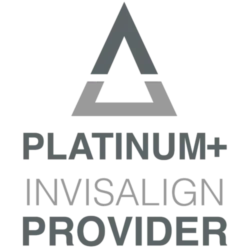 Our office provides the most state-of-the-art procedures available, ensuring optimal results for our patients. In addition to the Damon System, we also offer Invisalign as an alternative to braces. Invisalign is a revolutionary system that utilizes 3-D computer graphics to design and manufacture customized clear appliances called “Aligners”. Invisalign appliances are virtually undetectable, easy-to-use and comfortable to wear.
Our office provides the most state-of-the-art procedures available, ensuring optimal results for our patients. In addition to the Damon System, we also offer Invisalign as an alternative to braces. Invisalign is a revolutionary system that utilizes 3-D computer graphics to design and manufacture customized clear appliances called “Aligners”. Invisalign appliances are virtually undetectable, easy-to-use and comfortable to wear.
The invisible way to straighten your teeth, without braces. Invisalign® can give you the beautiful straight teeth you’ve always wanted. It works through a series of invisible, removable, and comfortable aligners that no one can tell you’re wearing. So you can smile more during treatment as well as after.
Invisalign uses the latest 3-D computer technology to create your customized aligners. You wear each aligner for about 2 weeks and then change to the next aligners. You will receive 2-4 aligners at each visit and be scheduled to return in 4-8 weeks. Most patients need between 12-48 aligners and many patients require an additional 2-10 aligners or, in some cases, braces to achieve an ideal result. Either a glued-in retainer or a removable retainer will be necessary to maintain your result following treatment.
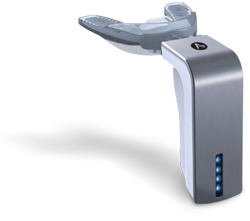 Stoutland & Hayes Orthodontics is excited to now offer AcceleDent, an accelerated treatment option that helps you achieve the smile you want in less time!
Stoutland & Hayes Orthodontics is excited to now offer AcceleDent, an accelerated treatment option that helps you achieve the smile you want in less time!
AcceleDent reduces orthodontic treatment time by 38%-50%. AcceleDent generates small vibrations or micropulses as teeth are guided by orthodontics. These micropulses accelerate the changing of the bones surrounding teeth to speed up tooth movement. AcceleDent is non-invasive and easy to use. All you do is insert the mouthpiece, which is fitted around your existing orthodontics, and turn on the activator for twenty minutes every day. Patients usually go about their normal daily tasks during the twenty minute activation period.
AcceleDent comes with a carrying shell, mouth piece, the activator, and the charging port. The charging port not only charges, but helps you and us track your success. AcceleDent is a Class II medical device that has been cleared for use by the FDA.
Ask us about incorporating AcceleDent as part of your treatment plan.
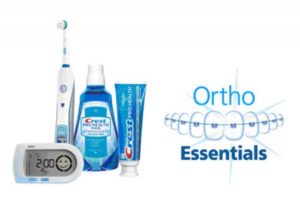 We are proud to offer our patients the Ortho Essentials oral hygiene program. It is our goal to help our patients have beautiful, healthy smiles as soon as possible. We believe that the Crest Oral-B Ortho Essentials oral hygiene program will help us get there!
We are proud to offer our patients the Ortho Essentials oral hygiene program. It is our goal to help our patients have beautiful, healthy smiles as soon as possible. We believe that the Crest Oral-B Ortho Essentials oral hygiene program will help us get there!
The Ortho Essentials program is a three-step oral hygiene program designed to boost oral health and hygiene practices for you, our orthodontic patient! When our patients have their braces placed one of our clinical team members will educate the patient on the importance of proper oral hygiene techniques and proper food choices. Our patients have the opportunity to be inducted into our Ortho Essentials oral hygiene program.
Each Ortho Essentials kit includes the Oral-B Triumph power toothbrush with a SmartGuide wireless display to provide feedback on brushing time and technique as well as the Crest Pro-Health Toothpaste and Rinse to help reduce plaque and gingivitis.
The Ortho Essentials kit also comes with an easy to follow 5-level Oral Hygiene Score Card ranging from poor to excellent. A score card that illustrates each level is provided to the patient so that our team members and the patient have a standard with which to compare their oral hygiene. At each orthodontic appointment a clinical team member will evaluate the patients oral hygiene using the 5-level score card and re-instruct as needed. A report card for that visit will be given to the patient. The greatest reward for maintaining excellent oral hygiene will be your beautiful, healthy smile at the completion of your orthodontic treatment.
Remember, it is very important to maintain regular hygiene appointments with your family dentist throughout orthodontic treatment!
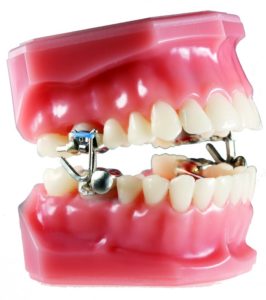
The MARA appliance (Mandibular Anterior Repositioning Appliance) is an effective way to correct overbites, and an improvement over headgears, which was often how comparable overbites used to be treated. Everything is inside the mouth so patients are less self-conscious during treatment. Also the Mara appliance cannot be removed, which means that patients won’t forget to wear it and slow down or disrupt treatment.
Anyone can thrust their lower jaw forward on their own. What MARA does is bring the lower jaw to this forward position, and then over time the mouth’s skeletal and muscular structure gradually adjusts to the new placement. With MARA, a metal device is attached to molars on both the upper and lower jaws. The lower appliance has short protrusions that slide along “elbows” in the upper appliance. MARA guides the lower jaw forward whenever the patient bites or closes their jaw. Patients will start to notice results almost immediately, but MARA is typically worn for 15 to 18 months to give time for the lower jaw to permanently grow into its new position.
The first few weeks of wearing MARA may feel a little strange, but patients get used to it rather quickly. MARA is used in conjunction with traditional braces, but it is only used about half the time of the full treatment time in braces.
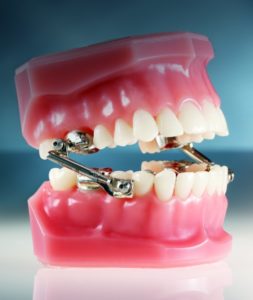
The Herbst appliance is used to correct overbites by bringing the lower jaw forward and allowing it to grow into its new position. The most distinctive feature of this appliance is two rods that connect the upper and lower arches. These rods, which fit inside tubes attached to the upper molars, are what draw the jaw forward over the months the appliance is worn, and the way the rods cleverly fit into the tubes allows the patient to open and close their mouth easily.
The Herbst appliance also has a palatal expander that’s attached to two upper molars and goes across the roof of the mouth. On a regular schedule, the patient or a parent/ adult uses a key to turn the expander. Gradually, the top of the mouth will widen, and when the upper jaw is wider, it will relieve overcrowding and give teeth the space to fit in with one other comfortably.
All in all, wearing the Herbst appliance means the patient will have a fair amount of metal in the mouth, and it typically takes a few weeks of getting used to it. The metal parts can irritate the inside of the cheeks or other parts of the mouth, but dental wax will provide a buffer. The tongue needs to get used to sharing the space with the expander, so talking and eating can be difficult at first. But after the mouth adjusts to the device, the problems typically will disappear and soon enough, the patient will be rewarded with a proportional, well-aligned jaw.
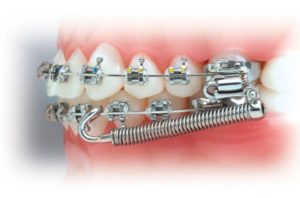
The Forsus device is used to treat overbites that are too pronounced to be corrected by rubber bands or similar methods. Nevertheless, the Forsus appliance is relatively lightweight, hard to notice, and can mean reduced time in braces. Also, unlike a headgear or elastics, the appliance is always in the mouth, so the patient doesn’t have to worry about following the orthodontist’s instructions carefully on a regular basis. The Forsus appliance is most often used during a patient’s teenage years when the jaw is growing rapidly.
The most distinctive aspect of a Forsus appliance is the spring that connects the upper and lower jaws. More specifically, the lower arch wire has a push rod that goes into the springs, and this arrangement moves the lower teeth forward while bringing the upper molars back. It doesn’t require adjustments. Once it’s in, it applies a light but continual pressure that moves the mouth to where it needs to go.
The Forsus appliance is worn in conjunction with braces. It can correct an overbite fairly quickly, within 3 to 6 months, and can help a patient avoid expensive and unpleasant jaw surgery. While it might take a few days to get used to eating and talking with the Forsus in your mouth, it’s fairly unobtrusive, and patients get used to it quickly.
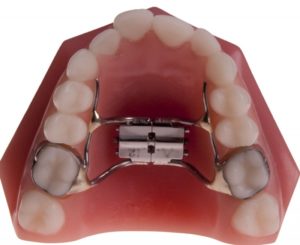
Sometimes as children grow up, their upper teeth don’t touch their lower teeth counterparts. Instead, they will close into the inside of the lower teeth on one side of the jaw or the other. This condition is a common type of malocclusion called a crossbite and can be caused by inherited factors, by adult teeth that didn’t displace baby teeth properly when they grew in, or by large tonsils. Whatever the cause, a crossbite should be corrected for both cosmetic and medical reasons.
The palatal expander (named so because it widens the palate, or roof of the mouth) is an appliance frequently used to correct crossbites and widen narrow arches. The expander is attached to upper molars on either side of the palate with metal bands or plastic bonds. The patient or a parent uses a special key that fits into the expander to turn it once every night, or in some cases once in the morning and once at night. The turning of the key causes the arms of the expander to spread slightly. Over time, the bone will grow into its new, wider position.
After each turn of the key, the patient may experience discomfort, but a palatal expander doesn’t cause much pain. As expansion is ongoing, the upper teeth will develop spaces between them, but these spaces will fill in naturally once the expansion process ends. As with any orthodontic device, the patient may have trouble talking or eating at first but these issues go away quickly.